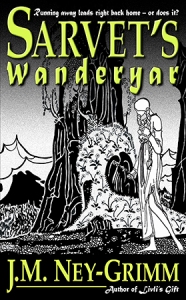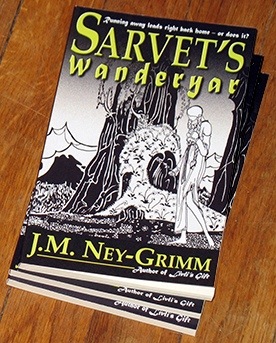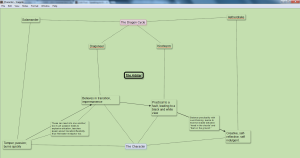 If the last book I read sated my taste for sword and sandal fantasy, Sarvet’s Wanderyar fits the bill for another craving: epic fantasy. J. M. Ney Grimm is a master at this genre, and I’ve been a fan of her work since the first paragraph I read; this book has been on my to-read list for quite a while, and I wasn’t disappointed.
If the last book I read sated my taste for sword and sandal fantasy, Sarvet’s Wanderyar fits the bill for another craving: epic fantasy. J. M. Ney Grimm is a master at this genre, and I’ve been a fan of her work since the first paragraph I read; this book has been on my to-read list for quite a while, and I wasn’t disappointed.
Sarvet is a young woman who suffers from a sort of palsy in one leg. Because of this, she’s held back; she’s relegated to menial chores, coddled by an overbearing mother, and–she believes–prevented from achieving her dreams. Sarvet’s need to prove herself drives her to request a Wanderyar–a year of exploring the world on one’s own–which is reserved only for young men. She’s tenacious and determined from the start, so her coming of age isn’t something that happens to her so much as something she forges for herself. This gives her a certain strength of character that’s lacking in a lot of literature. It’s easy to cheer her on and revel in her journey.
Sarvet’s disability is introduced very nicely. Subtle hints before coming out and saying it makes for a reveal that’s not surprising, but not really expected either. A good set up for what will be an important plot point; she doesn’t beat you over the head with it, a sin that is far too easy to commit in writing. This also puts the focus more on her character and less on the disability, making for a nicely rounded heroine that’s easy to sympathize with. That, in turn, makes this much more than a run of the mill coming of age novel–it’s an entrancing story with a character you care about, and desperately want to succeed.
Sarvet, for all her determination and will, is also a tad naive. This serves the story well; it sets her up as a young woman who, despite her disability, doesn’t realize just how difficult life can sometimes be. Failure is a very real consequence for her, and it’s all the more tangible because of her adolescent exuberance. You get the feeling that if she falls, she’s going to fall hard–but even if she recovers there’s an “I told you so” in the wings. The lesson is not so much in learning to succeed on her own as that sometimes, a little control is necessary.
This leads into the mother, Paiam. She’s fiercely protective of Sarvet, and while this overbearance serves as her call to action, Ney-Grimm does a good job of tempering and justifying it. Paiam isn’t just a controlling mother; Sarvet’s resistance is making that control seem more pronounced than it is. At first I saw Paiam as the clear antagonist, but I came to sympathize with her. This makes for a complex interaction between the two characters that rages almost completely in the subtext–very clever on Ney-Grimm’s part, and very effective. In fact, I sense that there’s a whole other story for Paiam, and I’d love to see her developed in another book.
Once the action gets moving, the reader is thrown into a wild set of circumstances that move further and further away from Sarvet’s familiar, tame world. It’s an escalation that nicely reflects the issues one faces in growing up; problems seem insurmountable until they’re not–and completely trivial in retrospect. There’s a certain shift in tone here as Sarvet goes from climbing a mountain to living among pegasi, and it serves well to show the stark differences between youth and adulthood. The metaphor may not be subtle, but it fits.
(On a side note, one of my favourite things about Ney-Grimm’s work is her treatment of fantastical creatures. She definitely doesn’t disappoint here–the pegasi seem ethereal but remarkably wise and strong; gentle but fearsome; creatures of light and gauze that are somehow the most real things in the world.)
As usual, the worldbuilding in this book is quite well done. Ney-Grimm has built a cohesive “universe” in which most of her stories take place, and each book explores similar but unique facets. I was a bit confused by some of the terms early in the book–holidays referred to as “Other-joy” and “Lodge day”–but the meaning became apparent as I progressed through the story. After I finished the book, I read a post on Ney-Grimm’s blog that explains that this lack of background is intentional. I can see her point, and agree with it–the worst thing you can do in worldbuilding is to bog the reader down with details that are, to a point, window dressing.
Otherwise, the worldbuilding is handled very well. It’s subtle in the first few pages. There’s a lot of information presented in a laid back, almost conversational way. While it left some questions for me, there weren’t enough gaps that it hampered my understanding, and what questions I had were answered before I got halfway through. Readers less familiar with Ney-Grimm’s “world” may have more of a challenge, but it’s nothing that would impede.
The moral of the story–beyond the coming of age themes–seems almost Taoist: resistance can sometimes cause more problems than it solves. It’s okay to stand up for one’s principles, but it’s the stiff branch that breaks in the wind. On the other hand, flying with the wind allows you to master it. It’s a powerful lesson used to great effect.
In the end, I have nothing but good things to say about this book, and wonder why it took me so long to get to reading it. I’ve always enjoyed Ney-Grimm’s work, but I particularly like this book–it’s one I can imagine one day reading to my children at bed-time, a fantastical adventure with a strong moral lesson. Absolutely worth a read!
J.M. Ney Grimm writes fantasy with a Norse twist. You can find Sarvet’s Wanderyar and other books of hers on Amazon, Kobo. iTunes, and B&N. She’s also on Twitter, and keeps a blog on writing (and often cooking!).


 One of my favourite genres to read is fantasy, and I’m partial to a certain sub-genre: sword and sandal. I love the Conan stories, and so I’ve been looking forward to a book that has a similar flavour: Wrath of the White Tigress by Davaid Alastair Hayden. Hayden has a unique flair for fantasy that’s pulpy in all the right ways. These are tales of sword and sorcery you would have found in Weird Tales or other magazines from the days of yore.
One of my favourite genres to read is fantasy, and I’m partial to a certain sub-genre: sword and sandal. I love the Conan stories, and so I’ve been looking forward to a book that has a similar flavour: Wrath of the White Tigress by Davaid Alastair Hayden. Hayden has a unique flair for fantasy that’s pulpy in all the right ways. These are tales of sword and sorcery you would have found in Weird Tales or other magazines from the days of yore.


